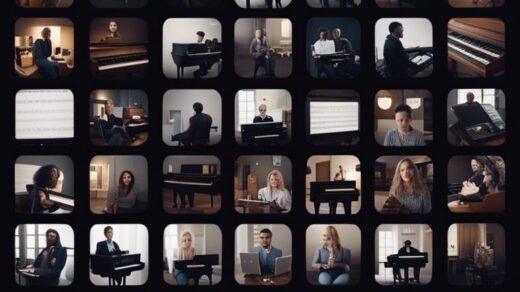With the rise of technology, interactive piano learning platforms offer a dynamic way to enhance your learning experience. By incorporating features like real-time feedback, interactive lessons, and gamified practice sessions, these platforms provide a personalized approach to learning the piano. Discover how these tools can transform your piano learning journey and help you reach your musical goals more effectively.
Key Takeaways:
- Engagement: Interactive piano learning platforms offer engaging features like gamification, progress tracking, and instant feedback to keep students motivated and interested.
- Personalized Learning: These platforms use AI algorithms to personalize lessons according to individual progress, learning styles, and goals, providing a tailored learning experience.
- Convenience: Learners can access interactive piano lessons anytime, anywhere, allowing for flexibility in practicing and learning at their own pace.

The Evolution of Piano Learning
Traditional Methods: Limitations and Drawbacks
For centuries, traditional methods of learning the piano have been the cornerstone of music education. These methods often involve one-on-one lessons with a teacher, practicing scales and exercises, and learning music theory. While this approach has its merits, it also comes with limitations. Personalized attention from a teacher can be expensive and not always accessible for everyone. Additionally, the rigid structure of traditional lessons may not cater to individual learning styles and pacing, leading to potential frustration and lack of engagement.
The Rise of Interactive Platforms: A New Era in Music Education
An exciting development in piano learning has been the rise of interactive platforms that offer a more engaging and accessible way to learn music. These platforms use technology to provide interactive lessons, feedback, and practice tools that cater to different learning styles. You can now learn the piano at your own pace, anytime and anywhere, with the help of virtual instructors and gamified learning experiences. This new era in music education is revolutionizing the way people learn piano, making it more enjoyable and effective than ever before.
Piano learning platforms leverage multimedia elements, such as videos, interactive sheet music, and performance analysis tools, to enhance your learning experience. You can receive instant feedback on your playing, track your progress over time, and even participate in online communities to share your achievements and seek advice from fellow learners. These interactive features not only make learning the piano more fun and engaging but also accelerate your progress and mastery of the instrument.
Engaging Interactivity
Gamification: Making Practice Fun and Competitive
Some people find traditional piano practice mundane and repetitive, leading to reduced motivation and progress. Interactive piano learning platforms often incorporate gamification elements to make practicing more enjoyable and engaging. By turning practice sessions into games or challenges, you are more likely to stay focused and committed to your learning goals. The element of competition, whether with yourself or others, can add an extra layer of excitement to your practice routine.
Real-time Feedback: Personalized Guidance for Improved Progress
On interactive piano platforms, real-time feedback is a game-changer in your learning journey. As you play along, the platform can analyze your performance instantly and provide personalized guidance to help you correct mistakes and improve your skills. This immediate feedback loop not only saves you time but also ensures that you are practicing effectively, targeting areas that need the most work. With this personalized guidance, you can monitor your progress more efficiently and tailor your practice sessions for maximum improvement.
Another benefit of real-time feedback is the ability to track your progress over time. By reviewing your performance data and practice history, you can identify patterns, set specific goals, and measure your improvement accurately. This feature not only keeps you motivated but also provides a clear roadmap for your piano learning journey.
Accessible Learning
Convenience and Flexibility: Learning at Your Own Pace
The interactive piano learning platforms offer you the convenience and flexibility to learn at your own pace. Unlike traditional lessons with strict schedules, you have the freedom to practice whenever you want, whether it’s early morning or late at night. This flexibility allows you to fit piano lessons seamlessly into your busy schedule without the stress of rushing to make it to a class on time.
The interactive nature of these platforms also means that you can pause, rewind, and replay lessons as many times as you need until you fully grasp the concept. This personalized approach to learning ensures that you can take your time to master each skill before moving on to the next, leading to a more successful and fulfilling learning experience.
Democratizing Music Education: Reaching a Wider Audience
Accessible to anyone with an internet connection, interactive piano learning platforms are democratizing music education by reaching a wider audience. Whether you’re a beginner or an advanced player, these platforms provide a level playing field for anyone interested in learning the piano. You no longer need to have access to expensive private lessons or prestigious music schools to enhance your musical skills.
With interactive piano learning platforms, geographical barriers are eliminated, allowing individuals from all corners of the world to access high-quality music education. This inclusivity not only expands the reach of music education but also fosters a diverse and vibrant community of learners passionate about honing their piano skills.
Enhanced Retention and Recall
After exploring interactive piano learning platforms, you will discover how they enhance the retention and recall of musical concepts and skills. These platforms offer a variety of features and tools designed to make learning more engaging, effective, and memorable.
Interactive Exercises: Reinforcing Musical Concepts and Skills
Musical concepts can be reinforced through interactive exercises that test your knowledge and understanding of key principles such as music theory, rhythm, and technique. By actively engaging with these exercises, you are not only learning new concepts but also reinforcing them through practice and application. This hands-on approach helps solidify your understanding and improves your ability to recall information when playing the piano.
Spaced Repetition: Optimizing Practice for Long-term Retention
An important feature of interactive piano learning platforms is spaced repetition, a learning technique that involves revisiting and practicing musical concepts at strategically spaced intervals. This method is proven to enhance long-term retention by optimizing the way you practice and review material. By spacing out your practice sessions and revisiting previously learned concepts over time, you strengthen your memory and improve your ability to recall information in the future.
Another benefit of spaced repetition is that it helps prevent forgetting and ensures that you retain the knowledge and skills you have acquired during your piano lessons. By incorporating spaced repetition into your practice routine, you can maximize your learning potential and make faster progress in your musical journey.

Personalized Learning Paths
Adaptive Technology: Tailoring Instruction to Individual Needs
Learning on interactive piano platforms is a personalized journey, with adaptive technology that tailors instruction to your individual needs. These platforms utilize algorithms to assess your playing abilities and learning pace, allowing you to progress at a pace that is just right for you. This personalized approach ensures that you are neither overwhelmed with material that is too advanced nor bored by content that is too easy. As you practice and play, the platform continuously adjusts the difficulty level to keep you challenged and engaged.
Identifying Strengths and Weaknesses: Focused Practice for Rapid Progress
Learning on interactive platforms involves identifying your strengths and weaknesses through focused practice strategies aimed at rapid progress. By analyzing your performance data, these platforms can pinpoint areas where you excel and areas that need improvement. This focused approach allows you to concentrate your practice efforts on specific skills that will have the most significant impact on your overall playing ability. As a result, you can make noticeable improvements in a shorter amount of time compared to traditional learning methods.
Understanding your strengths and weaknesses is crucial for your development as a pianist. By focusing on areas that need improvement, you can efficiently enhance your skills and become a more well-rounded musician. The targeted practice sessions provided by interactive platforms enable you to address specific challenges and make substantial progress in a short period, ultimately leading to a more gratifying and efficient learning experience.
Real-world Applications and Collaborations
Once again, interactive piano learning platforms open up a world of real-world applications and collaborations that enrich your piano learning experience. These platforms are not just about individual practice; they offer opportunities to engage in virtual recitals, collaborate with peers and mentors worldwide, and build valuable skills beyond just playing the piano.
Virtual Recitals and Performances: Building Confidence and Stage Presence
An imperative aspect of becoming a well-rounded pianist is the ability to perform confidently in front of an audience. Interactive piano learning platforms provide a safe space for you to participate in virtual recitals and performances. These opportunities allow you to showcase your skills, receive feedback from peers and mentors, and ultimately build your confidence and stage presence. By simulating real-life performance scenarios, you can overcome stage fright and improve your overall performance abilities.
Collaborative Learning: Connecting with Peers and Mentors Worldwide
Collaborations with other learners and experienced mentors worldwide are a unique feature of interactive piano learning platforms. This collaborative learning approach enables you to connect with like-minded individuals, share insights, and learn from each other’s experiences. By engaging in collaborative projects, such as group performances or duets, you not only improve your musical skills but also develop a sense of community and support within the online piano learning environment.
This collaborative learning aspect fosters a sense of camaraderie and encourages you to explore new musical genres, techniques, and perspectives. By connecting with peers and mentors worldwide, you can broaden your musical horizons, gain valuable feedback, and grow both as a pianist and as a part of a global learning community.
Summing up
Taking this into account, interactive piano learning platforms have revolutionized the way students learn to play the piano. By offering a wide range of features such as interactive lessons, real-time feedback, gamified learning, and social interaction, these platforms enhance the learning experience in ways that traditional methods cannot. They make the learning process more engaging, personalized, and accessible, ultimately helping you to progress faster and enjoy the journey of mastering the piano.
For those aspiring to teach piano online, platforms like these provide imperative tools for creating engaging and effective lessons. If you’re interested in learning more about how to teach online piano lessons, you can check out this informative article How To Teach Online Piano Lessons for valuable insights and strategies.
FAQ
Q: How do interactive piano learning platforms enhance the learning experience?
A: Interactive piano learning platforms enhance the learning experience by providing engaging and interactive lessons that cater to individual learning styles. These platforms often include features such as gamified learning, progress tracking, instant feedback, and interactive exercises that help students stay motivated and focused on their piano learning journey.
Q: What are the benefits of using interactive piano learning platforms?
A: Using interactive piano learning platforms can help students learn at their own pace, access a wide range of instructional materials, and receive personalized feedback from virtual instructors. These platforms also offer the flexibility to practice anytime, anywhere, and often include a variety of songs and exercises to keep learning fun and engaging.
Q: How can interactive piano learning platforms help improve practice consistency?
A: Interactive piano learning platforms use features like progress tracking, reminders, and practice schedules to help students build a consistent practice routine. By setting goals, tracking progress, and receiving regular feedback, students are encouraged to practice regularly and stay motivated to improve their piano skills.



